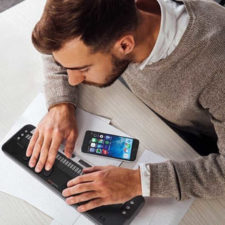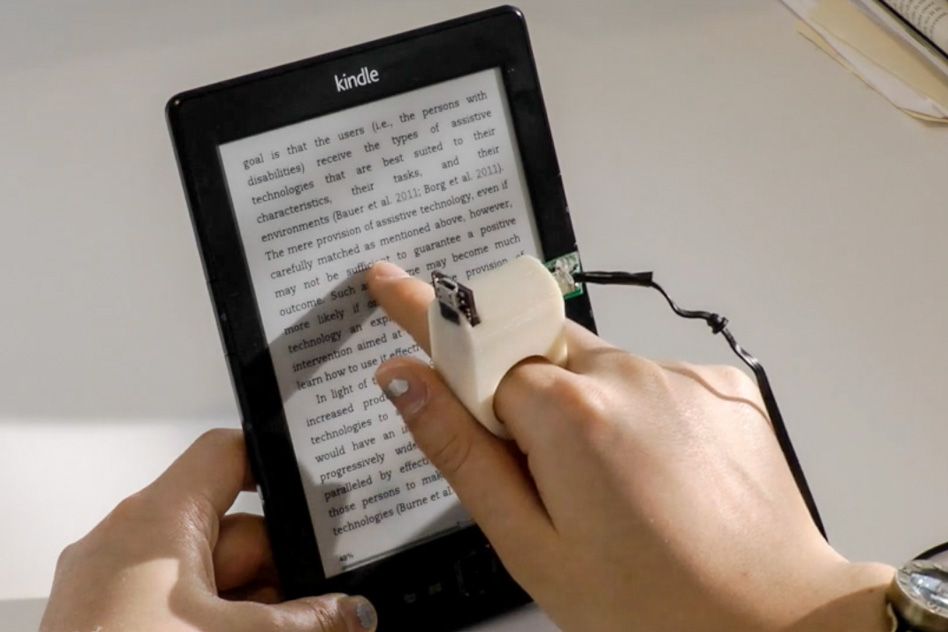Speech-to-Text Devices for Low Vision: Enhancing Accessibility
Wiki Article
Discover Ingenious Devices Designed for the Visually Damaged
The advancement of cutting-edge devices for the visually damaged represents a significant improvement in availability and freedom. Technologies such as smart glasses with AI capabilities and mobile applications designed to provide acoustic descriptions are reshaping day-to-day experiences for users.Smart Glasses for Navigating

Smart glasses designed for navigating are revolutionizing the means visually impaired individuals connect with their setting. These sophisticated tools make use of a combination of camera innovation, expert system, and acoustic responses to supply real-time information about surroundings. By employing challenge discovery systems, wise glasses can inform individuals to prospective hazards, enabling much safer wheelchair in both strange and familiar settings.
The integration of GPS modern technology better enhances navigating abilities, allowing customers to receive acoustic directions as they move. This hands-free method not only promotes independence yet likewise equips visually damaged individuals to browse metropolitan landscapes with raised confidence. In addition, lots of wise glasses are geared up with attributes that recognize spots and road signs, offering contextual details that improves the user experience.
Moreover, the development of these tools is continuously progressing, with firms functioning to enhance the accuracy of item acknowledgment and increase the range of navigational functions. As clever glasses come to be extra inexpensive and available, they hold the prospective to significantly change day-to-day life for aesthetically impaired users. Inevitably, these innovative tools stand for a critical step toward inclusivity, offering boosted wheelchair and a higher feeling of freedom for people browsing the world around them.

Mobile Apps for Daily Living
How can mobile applications boost the every day lives of aesthetically impaired individuals? Mobile apps are changing the method aesthetically impaired customers navigate their settings, manage daily jobs, and accessibility information. These applications provide necessary assistance through various capabilities, cultivating self-reliance and improving top quality of life.Several ingenious mobile apps are made specifically for everyday living. For circumstances, applications like Be My Eyes link visually impaired customers with sighted volunteers using video clip calls, enabling them to get real-time help with tasks such as checking out labels or browsing unfamiliar rooms. Similarly, Seeing AI, created by Microsoft, makes use of expert system to define surroundings, checked out text, and identify items, efficiently transforming a smartphone into a powerful device for daily help.
In addition, navigation apps tailored for the aesthetically impaired, such as Aira and BlindSquare, offer audio-based directions and environmental information, allowing individuals to traverse their environments securely and confidently. Past navigating and prompt support, mobile apps additionally sustain organization and task monitoring, with features that aid users establish tips, produce to-do lists, and track consultations. In summary, mobile applications work as indispensable resources, empowering aesthetically impaired people to lead even more independent and fulfilling lives.
Wearable Technologies for Aid
Empowerment via technology is increasingly evident in the world of wearable devices made to help aesthetically impaired people. These ingenious devices integrate seamlessly right into day-to-day live, boosting navigating and offering important responses to individuals. Wise glasses furnished with cameras can acknowledge faces and check out text out loud, permitting users to interact even more with confidence in social and professional setups.An additional noteworthy advancement is making use of haptic responses systems in wearable tools. These systems utilize resonances or other responsive signals to convey details regarding the user's environment, such as obstacles or modifications in terrain, boosting mobility and safety and security. Wearable modern technologies also consist of wristbands that attach to smart devices, informing users to notices via refined resonances, hence improving connectivity without dependence on aesthetic cues.
As these modern technologies proceed to advance, they are not only boosting independence for aesthetically damaged people however additionally promoting a higher sense of incorporation in culture. By connecting the space in between difficulties dealt with in everyday living and the capacity for freedom, wearable technologies work as critical tools in the pursuit for equality and empowerment for those with aesthetic disabilities.
Sound Description Devices
Audio summary tools play an important function in enhancing accessibility for visually impaired individuals, offering them with the capability to involve with aesthetic media. Braille displays and notetakers. These devices use narrated summaries of key aesthetic elements in films, television programs, and live efficiencies, ensuring that customers can fully understand the context and feelings shared through visualsAudio summary can be integrated into different systems, including streaming services, cinema testings, and live cinema. Many prominent streaming services currently include audio description as an availability feature, permitting customers to pick it quickly. Along with conventional media, specialized apps additionally exist, providing audio descriptions for art exhibitions, museums, and various other social occasions.
The performance of audio summary depends upon the ability of the storytellers, who need to share visual details succinctly without interfering with the initial audio. Developments directory in this area are also paving the method for more personalized experiences, where customers can change the degree of detail and pacing according to their preferences.
Braille Innovations and Gadgets
Braille developments and devices have dramatically transformed the means aesthetically impaired individuals communicate with text and information. Modern developments have actually caused the growth of functional tools that boost literacy and freedom among users. Especially, Braille show technologies have actually developed, enabling for dynamic reading experiences. These gadgets convert digital text into Braille, enabling users to access a large array of details on smart devices, computer systems, and tablets.
Moreover, portable Braille notetakers incorporate conventional Braille input with contemporary capabilities, facilitating note-taking, scheduling, and document editing and enhancing on the go. OCR devices for the blind. These compact gadgets commonly include text-to-speech capacities, linking the space between Braille and auditory details
In enhancement, innovative Braille printers have emerged, permitting customers to generate Braille labels, records, and academic products efficiently. This availability promotes better participation in professional and academic atmospheres, inevitably promoting inclusivity.
In addition, study right into wise Braille innovations remains to expand. Tools that integrate expert system are being discovered to give real-time navigation assistance and contextual info, enhancing the individual experience in varied settings. Generally, these technologies show a dedication to empowering aesthetically damaged people with innovation, ensuring they can quickly accessibility and engage with the globe around them.

Conclusion
The improvement of innovative tools for the aesthetically impaired considerably boosts independence and quality of life. These technologies not only foster better incorporation but likewise promote freedom in everyday activities, inevitably contributing to an extra fair and obtainable society for aesthetically impaired individuals.As wise glasses end up being a her explanation lot more accessible and inexpensive, they hold the potential to dramatically change day-to-day life for visually impaired individuals. Mobile apps are reinventing the method visually impaired users navigate their settings, manage day-to-day jobs, and accessibility details. Apps like Be My Eyes attach visually damaged customers with sighted volunteers by means of video clip calls, enabling them to receive real-time assistance with tasks such as checking out labels or navigating unknown areas.Additionally, navigating applications tailored for the visually damaged, such as Aira and BlindSquare, provide audio-based directions and environmental info, making it why not find out more possible for customers to traverse their environments securely and confidently.The innovation of innovative devices for the aesthetically impaired dramatically enhances freedom and high quality of life.
Report this wiki page